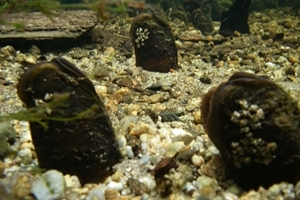Freshwater pearl mussel
 The UK is home to six native freshwater species of mussels, one of which is amongst the rarest animals in the world and something very few of us will ever encounter – the freshwater pearl mussel (Margaritifera margaritifera).
The UK is home to six native freshwater species of mussels, one of which is amongst the rarest animals in the world and something very few of us will ever encounter – the freshwater pearl mussel (Margaritifera margaritifera).
The freshwater pearl mussel is slow-growing, large in size and arguably the longest-living of all the river fauna. Found only in pristine rivers with sandy, cobbly bottoms, they are known to have lifespans of over 100 years. This might seem strange for a mollusc, but this longevity is necessary due to their clever and complex life cycle.
The shell can reach 15cm in length and is characteristically oval, black and ‘corroded’ in appearance, which differentiates it from the other types of large mussels. The inside of the shell is pearly white, and like many other bivalve molluscs they have a frilly-looking filter feeding system poking out of the top and a muscular ‘foot’ beneath to anchor themselves down.
They sit half-buried in deposits of sand and fine gravels in the riverbed, often butting themselves up alongside cobbles for protection. Juveniles, which are lighter brown, like to bury themselves completely under stones. Healthy colonies consist of many hundreds of variably sized mussels crowded together, which may span the length and width of suitable stretches of river.
As well as a rough substrate and clear, unpolluted water, the vital ingredient of a pearl mussel river is a good population of salmon and brown trout. This is because when mussels reproduce, they emit clouds of little larvae called ‘glochidia’, which resemble tiny open mussels. In a Pac-Man fashion they swim into the water column and are inhaled by salmonids, and inside the gills they simply snap on and hitch a ride. As many as 5,000 of these little mussels can be found in a single fish (who remain oblivious, apparently) and they latch on for at least six months until they have been carried upstream. Here they drop off and anchor to the new riverbed. A very clever dispersal method for an otherwise sedentary animal, even if they do have to produce 200 million glochidia in a lifetime to make it worthwhile!
Young mussels start off eating algae and bacteria from the riverbed, and then at around five years old their gills have developed enough to filter organic particles from the water. Each adult will filter a bath-sized volume of water in a day, so you can imagine how large beds of thousands of mussels can make a big positive impact on water quality.
Many rivers these days suffer from poor water quality, but most dangerous to pearl mussels is the accumulation of sediment, which chokes the juveniles. Adults have some resilience to silt, but if the young cannot survive, an ageing population develops. In many UK colonies the youngest mussels are 30 years or older, which is sobering to the point where scientists have kick-started captive breeding.
Millennia ago, they were once widespread across Europe and parts of North America. Now, fewer than 50 rivers in the world support viable breeding populations of freshwater pearl mussels, and those locations, as well as the mussels themselves, are protected by law. And for good reason – as well as river degradation and falling salmon stocks, they have been historically clobbered by pearl hunters.
A very small proportion produce a true freshwater pearl, which is very small, and white or pinkish depending on the colour of the mother shell. It can only be retrieved by prising open the two halves of the shell and tearing the soft tissue inside, killing the mussel, so you can imagine the tragic impact on a population when hundreds of decades-old animals are killed in return for a single pearl, and sometimes none.
Rumour has it that British rivers were once so rich in pearl mussels that their abundance and promise of pearl riches were a factor in the invasion of the Romans in 55 BC. In the centuries that followed, freshwater pearls were traded for commanding prices, and became commercially exploited to the extent that in the 19th Century the pearl harvest had become unsustainable. Small-scale pearl fishing continued until complete legal protection was introduced in 1998, but by this time very few remained and illegal poaching is still reported today in the stronghold of Scotland.
I hope the future looks up for the freshwater pearl mussel, and that efforts to breed and release juveniles are fruitful. If you know where some live, keep it to yourself, but if you never see them, take pleasure in imagining these wonderful elderly bio-engineers huddled together, looking skyward through clear cold waters, and their young hitch-hiking on salmon as they leap upstream.
Jess Brooks
Advisory
Photo credit: Joel Berglund